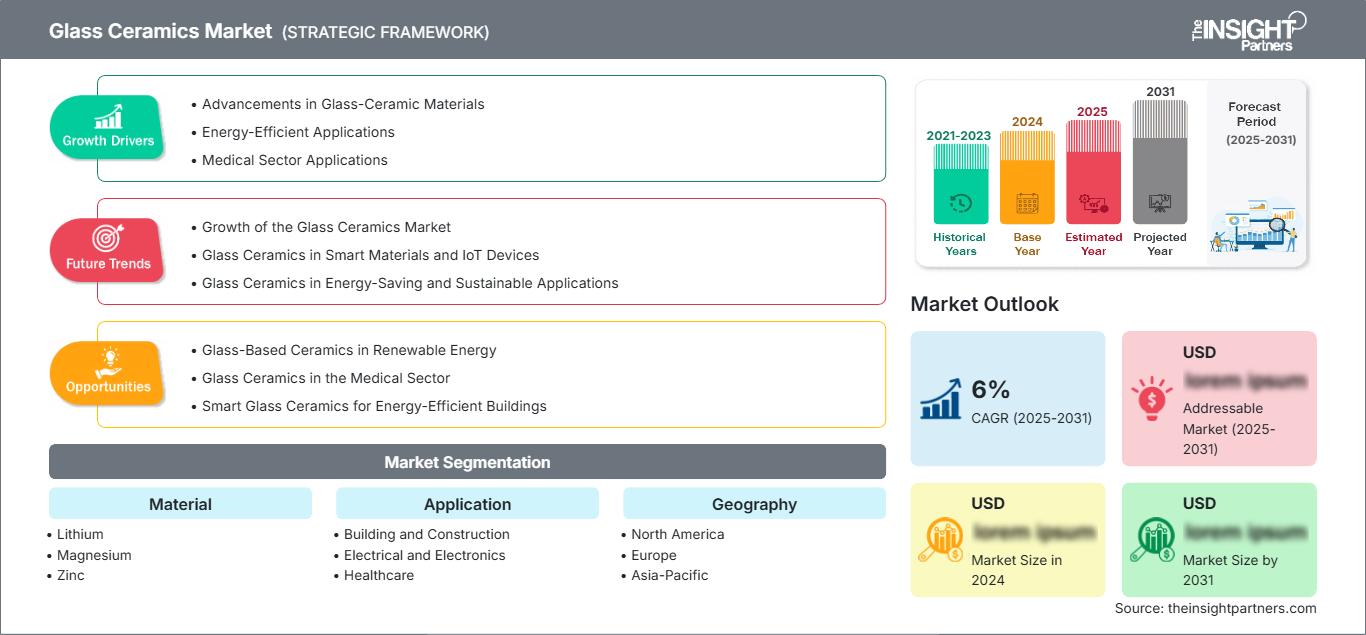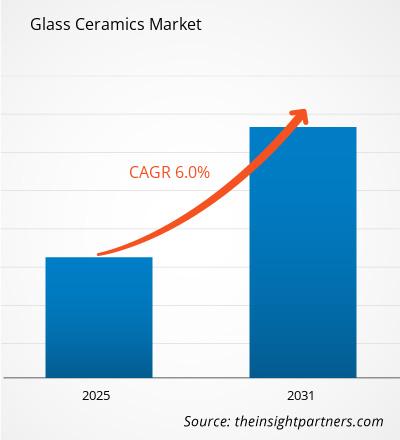Der Markt für Glaskeramik wird voraussichtlich zwischen 2025 und 2031 eine durchschnittliche jährliche Wachstumsrate (CAGR) von 6 % verzeichnen, wobei die Marktgröße von XX Millionen US-Dollar im Jahr 2024 auf XX Millionen US-Dollar im Jahr 2031 anwachsen wird.
Der Bericht ist nach Material (Lithium, Magnesium und Zink) segmentiert. Die globale Analyse ist weiter nach Regionen und wichtigen Ländern aufgeschlüsselt. Der Bericht enthält außerdem Analysen basierend auf der Anwendung (Bauwesen und Konstruktion, Elektrik und Elektronik, Gesundheitswesen, Luft- und Raumfahrt, Optik und andere Anwendungen). Die globale Analyse ist weiter nach Regionen und wichtigen Ländern aufgeschlüsselt. Der Umfang umfasst die Marktgröße und -prognose auf globaler, regionaler und Länderebene für alle wichtigen Marktsegmente. Der Bericht bietet den Wert in USD für die oben genannte Analyse und die Segmente. Der Bericht enthält wichtige Statistiken zum Marktstatus der wichtigsten Marktteilnehmer und bietet Markttrends und -chancen.
Zweck des Berichts
Der Bericht „Glaskeramikmarkt“ von The Insight Partners beschreibt die aktuelle Situation und das zukünftige Wachstum sowie die wichtigsten treibenden Faktoren, Herausforderungen und Chancen. Dadurch erhalten verschiedene Geschäftsinteressenten Einblicke, wie z. B.:
- Technologieanbieter/-hersteller: Um die sich entwickelnde Marktdynamik zu verstehen und die potenziellen Wachstumschancen zu erkennen, damit sie fundierte strategische Entscheidungen treffen können.
- Investoren: Um eine umfassende Trendanalyse hinsichtlich der Marktwachstumsrate, der finanziellen Marktprognosen und der Chancen entlang der Wertschöpfungskette durchzuführen.
- Regulierungsbehörden: Um Richtlinien und Überwachungsaktivitäten auf dem Markt zu regulieren, mit dem Ziel, Missbrauch zu minimieren, das Vertrauen der Investoren zu wahren und die Integrität und Stabilität des Marktes aufrechtzuerhalten.
Glaskeramik-Marktsegmentierung Material
- Lithium
- Magnesium
- Zink
Anwendung
- Bauwesen
- Elektronik und Elektronik
- Gesundheitswesen
- Luft- und Raumfahrt
- Optik
- Andere Anwendungen
Sie erhalten kostenlos Anpassungen an jedem Bericht, einschließlich Teilen dieses Berichts oder einer Analyse auf Länderebene, eines Excel-Datenpakets sowie tolle Angebote und Rabatte für Start-ups und Universitäten.
Glaskeramikmarkt: Strategische Einblicke

- Holen Sie sich die wichtigsten Markttrends aus diesem Bericht.Dieses KOSTENLOSE Beispiel umfasst Datenanalysen, die von Markttrends bis hin zu Schätzungen und Prognosen reichen.
Wachstumstreiber für Glaskeramik
- Fortschritte bei Glaskeramikmaterialien: Veränderungen in den Produktionsmustern und der chemischen Zusammensetzung von Glaskeramik beschleunigen die Marktentwicklung. Beispielsweise wurden Glaskeramikmaterialien entwickelt, die eine höhere Festigkeit, Temperaturbeständigkeit und Korrosionsbeständigkeit aufweisen, und ihre Verwendung hat neue Sektoren wie die Elektronik, die Flugzeugindustrie und die chirurgische Instrumentenindustrie erschlossen.
- Energieeffiziente Anwendungen: Glaskeramik wird zunehmend für energieeffiziente Anwendungen wie Kochplatten und Kühlkörper eingesetzt. Ihre Fähigkeit zur Wärmespeicherung und -verteilung hat sowohl im privaten als auch im gewerblichen Bereich Anklang gefunden und den Trend zu umweltfreundlichen und energiesparenden Lösungen vorangetrieben.
- Anwendungen im medizinischen Sektor: Innovationen in der Glaskeramiktechnologie werden auch im medizinischen Sektor eingesetzt, insbesondere bei Implantaten und Bildgebungssystemen. Ihre einzigartigen Eigenschaften wie Biokompatibilität, Festigkeit und die Fähigkeit, jede beliebige Form anzunehmen, machen sie für extreme Anwendungen wie Zahnimplantate, chirurgische Instrumente und Knochenzement so nützlich.
Zukünftige Trends im Glaskeramikmarkt
- Wachstum des Glaskeramikmarktes: Das Wachstum des Glaskeramikmarktes ist auf die zunehmende Nutzung dieser Materialien in Spitzentechnologien wie Quantencomputern, der Luft- und Raumfahrt und hochentwickelten medizinischen Geräten zurückzuführen. Sie verfügen über ideale mechanische, thermische und elektrische Eigenschaften für Hightech-Anwendungen, was die Weiterentwicklung und Erforschung dieser aufstrebenden Branchen fördert.
- Glaskeramik in intelligenten Materialien und IoT-Geräten: Bei der Entwicklung intelligenter Materialien, die hauptsächlich in Geräten des Internets der Dinge (IoT) zu finden sein werden, wird ein umfassender Einsatz von Glaskeramik erwartet. Die Widerstandsfähigkeit gegenüber extremen Bedingungen, unter denen Sensoren, Aktoren und andere elektronische Teile arbeiten, ist hoch, daher sind diese Materialien eine Voraussetzung für fortschrittliche vernetzte Geräte.
- Glaskeramik in energiesparenden und nachhaltigen Anwendungen: Aufgrund des steigenden Umweltbewusstseins wird Glaskeramik verstärkt in energiesparenden Anwendungen eingesetzt. Die thermischen Eigenschaften der Glaskeramik machen sie zu effektiven Energiesparmaterialien in Gebäuden, Geräten und sogar in der Industrie. Darüber hinaus passt ihre Robustheit und Recyclingfähigkeit perfekt zum aktuellen Fokus auf nachhaltige und langlebige Materialien.
Marktchancen für Glaskeramik
- Glasbasierte Keramik in erneuerbaren Energien: In den letzten Jahren hat die Anwendung von Glaskeramik für erneuerbare Energiequellen, insbesondere im Bereich Solarenergie und Energiespeichersysteme, an Bedeutung gewonnen. Ihre hohe thermische Stabilität, Langlebigkeit und Isoliereigenschaften machen sie sehr nützlich in Solarmodulen, thermoelektrischen Systemen sowie Wärmespeichersystemen, was ein großes Potenzial im Bereich der grünen Energie darstellt.
- Glaskeramik im medizinischen Sektor: Der steigende Bedarf an verbesserten Materialien im medizinischen Sektor eröffnet Glaskeramiken eine Nische bei der Entwicklung bioaktiver Implantate, Zahnkronen und Prothesen. Ihre Verträglichkeit mit menschlichem Körpergewebe, ihre Festigkeit und ihre Widerstandsfähigkeit gegen Verschleiß und Korrosion machen sie für modernste medizinische Geräte und Gesundheitslösungen geeignet.
- Intelligente Glaskeramik für energieeffiziente Gebäude: Mit der zunehmenden Beliebtheit intelligenter Materialien wurden Glaskeramiken mit entsprechenden integrierten Technologien hergestellt, beispielsweise zur Veränderung von Farbe, Wärme- oder Lichtdurchlässigkeit. Darüber hinaus stellt die Nachfrage nach intelligenten Fenstern und energieeffizienten Gebäuden einen positiven Trend dar, da diese Materialien den Komfort erhöhen und Energie sparen und sie somit für moderne Architektur und Stadtplanung attraktiv machen.
Regionale Einblicke in den Glaskeramikmarkt
Die Analysten von The Insight Partners haben die regionalen Trends und Faktoren, die den Glaskeramikmarkt im Prognosezeitraum beeinflussen, ausführlich erläutert. In diesem Abschnitt werden auch die Marktsegmente und die geografische Lage in Nordamerika, Europa, dem asiatisch-pazifischen Raum, dem Nahen Osten und Afrika sowie Süd- und Mittelamerika erörtert.
Umfang des Marktberichts über Glaskeramik
| Berichtsattribut | Einzelheiten |
|---|---|
| Marktgröße in 2024 | US$ XX million |
| Marktgröße nach 2031 | US$ XX Million |
| Globale CAGR (2025 - 2031) | 6% |
| Historische Daten | 2021-2023 |
| Prognosezeitraum | 2025-2031 |
| Abgedeckte Segmente |
By Material
|
| Abgedeckte Regionen und Länder | Nordamerika
|
| Marktführer und wichtige Unternehmensprofile |
|
Dichte der Marktteilnehmer für Glaskeramik: Verständnis ihrer Auswirkungen auf die Geschäftsdynamik
Der Markt für Glaskeramik wächst rasant. Die steigende Nachfrage der Endverbraucher ist auf Faktoren wie veränderte Verbraucherpräferenzen, technologische Fortschritte und ein stärkeres Bewusstsein für die Produktvorteile zurückzuführen. Mit der steigenden Nachfrage erweitern Unternehmen ihr Angebot, entwickeln Innovationen, um den Bedürfnissen der Verbraucher gerecht zu werden, und nutzen neue Trends, was das Marktwachstum weiter ankurbelt.

- Holen Sie sich die Glaskeramikmarkt Übersicht der wichtigsten Akteure
Wichtige Verkaufsargumente
- Umfassende Abdeckung: Der Bericht analysiert umfassend Produkte, Dienstleistungen, Typen und Endnutzer des Glaskeramikmarktes und bietet einen ganzheitlichen Überblick.
- Expertenanalyse: Der Bericht basiert auf dem umfassenden Verständnis von Branchenexperten und Analysten.
- Aktuelle Informationen: Der Bericht gewährleistet Geschäftsrelevanz durch die Berichterstattung über aktuelle Informationen und Datentrends.
- Anpassungsoptionen: Dieser Bericht kann an spezifische Kundenanforderungen angepasst werden und passt sich optimal an die Geschäftsstrategien an.
Der Forschungsbericht zum Glaskeramikmarkt kann daher dazu beitragen, die Branchensituation und die Wachstumsaussichten zu entschlüsseln und zu verstehen. Obwohl es einige berechtigte Bedenken geben kann, überwiegen die Vorteile dieses Berichts tendenziell die Nachteile.
- Historische Analyse (2 Jahre), Basisjahr, Prognose (7 Jahre) mit CAGR
- PEST- und SWOT-Analyse
- Marktgröße Wert/Volumen – Global, Regional, Land
- Branchen- und Wettbewerbslandschaft
- Excel-Datensatz
Aktuelle Berichte
Verwandte Berichte
Erfahrungsberichte
Grund zum Kauf
- Fundierte Entscheidungsfindung
- Marktdynamik verstehen
- Wettbewerbsanalyse
- Kundeneinblicke
- Marktprognosen
- Risikominimierung
- Strategische Planung
- Investitionsbegründung
- Identifizierung neuer Märkte
- Verbesserung von Marketingstrategien
- Steigerung der Betriebseffizienz
- Anpassung an regulatorische Trends




















 Kostenlose Probe anfordern für - Glaskeramikmarkt
Kostenlose Probe anfordern für - Glaskeramikmarkt